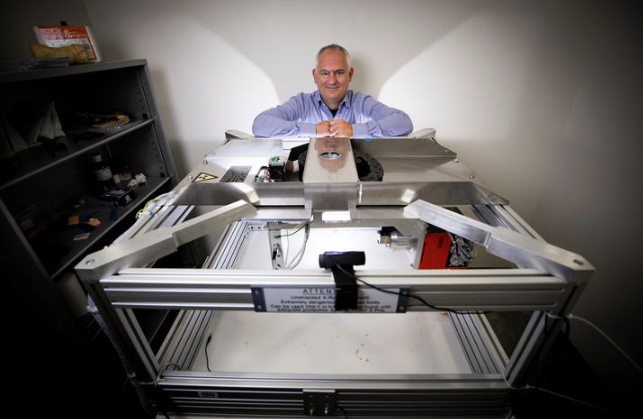UK’s Brent Seales launches global competition to decipher Herculaneum scrolls

They are among the most iconic and inaccessible of the world’s vast collection of damaged manuscripts.
Burned and buried in the eruption of Mount Vesuvius in 79 CE, the Herculaneum scrolls offer a unique window to the ancient world.
Unfortunately, they are too fragile to unroll.
But now, you can help resurrect the ancient library from the volcanic ashes. Brent Seales, a computer science professor at the University of Kentucky, is leading a global competition to read the charred scrolls after demonstrating that an artificial intelligence program (AI) can successfully extract letters and symbols from X-ray images of the unrolled papyri (EduceLab-scrolls).
“Faculty and student researchers are great at providing breakthroughs, and we've done that. We've proven that virtual unwrapping and machine-learning ink detection works on the Herculaneum scrolls,” Seales said. “What a competition can do now is amplify and accelerate those breakthroughs — refining them in ways that would take us years to achieve on our own.”
For more than two decades, Seales and his dedicated team — of staff and student researchers with the Digital Restoration Initiative, part of EduceLab — have doggedly labored to create high-tech, noninvasive tools to rescue hidden texts and restore them to humanity.
As part of the Vesuvius Challenge, Seales’ team is releasing its software and thousands of 3D X-ray images of two rolled-up scrolls and three papyrus fragments.
The hope is that $500,000 in prizes encourages global researchers and scholars to build upon the AI technology and accelerate the decoding of the only intact library to survive from ancient times.
Teams that enter will compete for a grand prize of $150,000 — awarded to the first to read four passages of text from the inner layers of the scrolls by the end of 2023. Progress prizes include $50,000 for accurately detecting ink on the papyri from the 3D X-ray scans.
“Another exciting dimension of the competition is the opportunity it affords our own students,” Seales explained. “To place them on a global stage this way — working behind the scenes with Silicon Valley executives and experts in the field, enhances their training and their capabilities.”
The two unopened scrolls, belonging to the Institut de France in Paris, are among hundreds unearthed in the 1750s when excavations at the buried villa revealed an extravagant library of Epicurean philosophical text. They are believed to have belonged to a Roman statesman — possibly Lucius Calpurnius Piso Caesoninus, the father-in-law of Julius Caesar.
In 2016, Seales' developed the Volume Cartographer, a revolutionary computer program for locating and mapping 2D surfaces within a 3D object. The software pipeline is used with micro-CT to generate extremely high-resolution images — enabling the ability to read a document without ever needing to physically open it. The charred scroll from En Gedi was the first complete text to be revealed using the software.
Because it works with X-rays, the Volume Cartographer software relies on the presence of metals in ink to help distinguish the writing from the surface on which it sits. But Herculaneum ink is different from that used to pen ancient Hebrew and medieval documents. It's made of carbon, which is invisible to the human eye in micro-CT images.
To address this problem, Seales and team developed a neural network that "learns" how patterns in the data look when ink is present, as opposed to how patterns appear when no ink is present. A machine learning algorithm is trained to detect and recognize the unique data signatures. The groundbreaking work was first featured in a PLOS ONE article.
“No one can cast blame at past researchers, because no other time in history has afforded us the technological advances and collaborative spirit that exists now,” Seales explained. “Plus, there is a renewed interest in the classics. We have this realization that people may not always appreciate the great writings, literature and philosophy of the past. All of these issues make now the perfect time to open this challenge up to the world."
The team remains confident they are on the cusp of being able to completely read the ink, and collaboration from fellow researchers could finally lead to a more complete understanding of the scrolls.
“We believe others will benefit and extend our findings in very positive and meaningful ways that will inspire accelerated developments,” Seales said.
He is considered the foremost expert in the digital restoration of cultural antiquities. To this day, his quest to uncover ancient Western wisdom is ever evolving.
And though, at times, progress is slow and breakthroughs seem distant — Seales believes the Herculaneum papyri will succumb to modern technology and, more importantly, to his team’s determination by the end of this year.
“We plan to keep showing the world what can be done, right here at UK," he said. "Overcoming damage incurred during a 2,000-year span is no small challenge. But that’s what we do in Kentucky — conquer the seemingly impossible."
UKNow has chronicled Seales’ unprecedented work through a series of stories over the years. This summer, we plan to take a look back at his decades-long journey that has garnered national and international attention.
You can learn more about the Vesuvius Challenge here, and you can learn more about the Digital Restoration Initiative here. Contact Lindsey Piercy, University of Kentucky Public Relations to schedule an interview or media appearance with Dr. Brent Seales to discuss the Herculaneum Scrolls.
Credits
Words: Lindsey Piercy (Public Relations & Strategic Communication)
Photo: Pete Comparoni (UK Photo)

